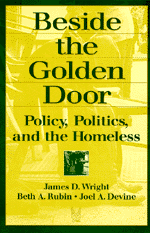

![]()
![]()

One of the book's principal arguments is that homelessness has grown in recent years because poverty rates have increased - along with decreases in welfare payments and real minimum wages - at the same time as the supply of low-income housing diminished. The authors refute the assertion by Baum and Burnes, A Nation in Denial: The Truth about Homelessness (1993), that homelessness is the result of personal disabilities of the individuals affected, principally ADM disorders (alcohol, drug, and mental illness). Wright et al. demonstrate that, while many, perhaps most, homeless people are affected by mental illness or substance abuse, these factors alone do not provide a causal explanation of the rise of homelessness. Poverty and housing trends have created a situation which inevitably means that many people will be without shelter; personal factors such as mental illness or substance abuse help to predict who are those most likely to be affected. It comes as no surprise that those on the streets are drawn largely from the pool of marginalized people most at risk; this does not, however, provide an explanation of causal factors. The authors make a convincing case that "blaming the victim" diverts attention from the key issues of housing, poverty, welfare, and pubic policy. Moreover, they emphasize that treatment for ADM disorders are ineffective, focussing on symptoms rather than on underlying structural problems, and do not bring about lasting improvements.
Beside the Golden Door explores the issues and difficulties involved in attempts to count the homeless, which has been an obsessive exercise in the United States. They detail the ill-fated censuses in 1990: these S-night manouvres failed to identify from one-third to four-fifths of decoys placed in the cities, they missed a substantial number of informal shelters, they were confined to only limited districts of the cities, and they could not account for those individuals who intentionally avoided the intrusive census, which had been announced in advance.
Wright has been involved with health issues for a very long time, was the principal investigator of the Health Clinics for the Homeless clinics in American cities, and has written extensively on the subject (Wright and Weber, 1987, Homelessness and Health. Washington, DC:McGraw Hill). Consequently, this collection of papers, essays, and speeches is most effective in describing the health issues associated with homelessness, including mental illness and substance abuse, the shortcomings of alcohol and drug treatments, and the muddled situation in which poor health is both a cause and a result of life on the street. The final two chapters before the Conclusion, dealing with rural homelessness and the situation overseas (Europe and Honduras) are less effective and somewhat disconnected from the flow of the remainder of the collection, which is focussed exclusively on the United States.
Nevertheless, this collection is useful for general readers and interested students who seek an explanation of the phenomenon of homelessness, a review of the main theories and arguments surrounding this issue, and, in particular, the close ties between life on the street and poor health.
Gerald Daly
Faculty of Environmental Studies
York University, Toronto
